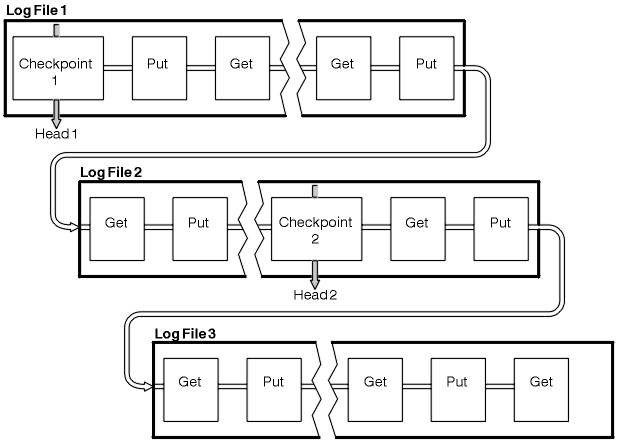Using checkpointing to ensure complete recovery
Checkpoints synchronize queue manager data and log files, and mark a point of consistency from which log records can be discarded. Frequent checkpointing makes recovery quicker.
Persistent updates to message queues happen in two stages. First, the records representing the update are written to the log, then the queue file is updated. The log files can thus become more up to date than the queue files. To ensure that restart processing begins from a consistent point, WebSphere® MQ uses checkpoints. A checkpoint is a point in time when the record described in the log is the same as the record in the queue. The checkpoint itself consists of the series of log records needed to restart the queue manager; for example, the state of all transactions (units of work) active at the time of the checkpoint.
WebSphere MQ generates checkpoints automatically. They are taken when the queue manager starts, at shutdown, when logging space is running low, and after every 10 000 operations logged.
As the queues handle further messages, the checkpoint record becomes inconsistent with the current state of the queues.
When WebSphere MQ restarts, it finds the latest checkpoint record in the log. This information is held in the checkpoint file that is updated at the end of every checkpoint. The checkpoint record represents the most recent point of consistency between the log and the data. All the operations that have taken place since the checkpoint are replayed forward. This is known as the replay phase. The replay phase brings the queues back to the logical state they were in before the system failure or shutdown. During the replay phase a list is created of the transactions that were in-flight when the system failure or shutdown occurred. Messages AMQ7229 and AMQ7230 are issued to indicate the progression of the replay phase.
In order to know which operations to back out or commit, WebSphere MQ accesses each active log record associated with an in-flight transaction. This is known as the recovery phase. Messages AMQ7231, AMQ7232 and AMQ7234 are issued to indicate the progression of the recovery phase.
Once all the necessary log records have been accessed during the recovery phase, each active transaction is in turn resolved and each operation associated with the transaction will be either backed out or committed. This is known as the resolution phase. Message AMQ7233 is issued to indicate the progression of the resolution phase.
WebSphere MQ maintains internal pointers to the head and tail of the log. It moves the head pointer to the most recent checkpoint consistent with recovering message data.
Checkpoints are used to make recovery more efficient, and to control the reuse of primary and secondary log files.
In Figure 1, all records before the latest checkpoint, Checkpoint 2, are no longer needed by WebSphere MQ. The queues can be recovered from the checkpoint information and any later log entries. For circular logging, any freed files before the checkpoint can be reused. For a linear log, the freed log files no longer need to be accessed for normal operation and become inactive. In the example, the queue head pointer is moved to point at the latest checkpoint, Checkpoint 2, which then becomes the new queue head, Head 2. Log File 1 can now be reused.
